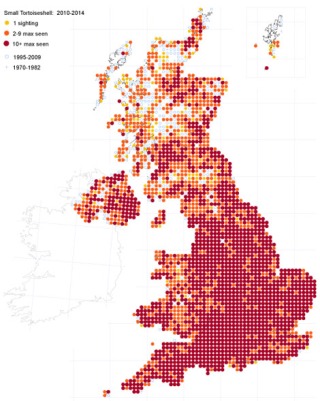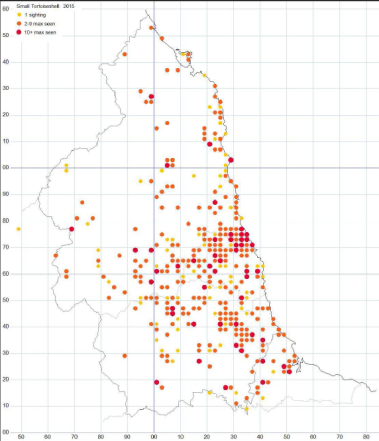
Featured image: Small Tortoise Shell ([1] @Mark Colvin)
- Class: Insecta
- Order: Lepidoptera
- Family: Nymphalidae
- Subfamily: Nymphalinae
- Genus: Agalais
- Species: urticae
Conservation Status: No Concern
Appearance:
- Wingspan: Male: 45 – 55mm Female: 52 – 62mm [1]
- Sexual dimorphism: No
- Wing Shape: Large wingspan, wing edges are waved and both forewings and hindwings have a small protrusion half way along the wing edge where wings stick out irregularly.
- Dorsal Wing: The base of each wing is brown, matching the body colour. The wing then turns to bright orange before a small dark black tip along the margin that contain blue spots. The orange wing segment contains one large black marking next to smaller black spots. At the anterior of the wing there is thick band of black and yellow stripes.
- Ventral Wing: Black from the body until turning pale brown/white half way up the wing. Anterior of wing has two black markings against the brighter background. The blow band of spots is present but not as visible and not as bright as the dorsal side.
- Body: Brown topside with a black underside.
Distribution:

The Small Tortoiseshell has been present on Earth for one of the longest times of any butterflies species [2]. They are widespread throughout the whole of Europe and temperate Asia [2]. Within Britain they inhabit all land area [1].
The Small Tortoiseshell is present in almost every habitat, ranging from suburban gardens to mountaintops [1,2,3]. They are most often sighted feeding in flower beds or egg laying in nettle beds [3].
Small Tortoiseshell populations have always been prone to fluctuation from year to year, however the populations have recently been declining [1,2]. This is thought to be as a result of an increase in parasitoid fly (Sturmia bella) impact due to global warming [1] but the fly is only expected to affect up to 18% of Small Tortoiseshells [2]. The causation behind recent decline is therefore unknown.
Populations in Britain are boosted each year by migrants from mainland Europe but the number of migrants is low and only a small proportion of the total population [2].
Life Cycle:
Small Tortoiseshells usually undergo 2 broods per year unless in the north (Scotland) where there is only one brood [1]. The larval foodplants are Common Nettles (Urtica dioica) and Small Nettles (Urtica urens) [1,2,3].
They are one of only four British species to hibernate over winter in their adult butterfly form [2, the other three being the Brimstone, Comma and the Peacock.
Butterfly: The butterfly can be seen all year round as during hibernation in winter they can awake if temperatures reach high enough [1]. Hibernation usually starts at the end of September and ends in March [1,2]. The second brood during summer will emerge during late August and will spend a long time feeding in preparation for hibernation [1,2]. Second brood populations are always much higher than first broods [2].
Eggs: The small green eggs are laid in large cluster of around 80-100 eggs, piled on top of each other upon the underside of the foodplant leaves [1,2]. The eggs are always laid in direct sunlight areas and preferably on young leaves [2]. Females can be very choosy about egg sites and it can take between 20-90 minutes to deposit the eggs [1]. Eggs will hatch after 1-2 weeks depending on the environmental temperature [1,2].
Caterpillar: Upon hatching in either May or July the groups of caterpillars will immediately eat their egg shells and spin a communal web at the top of the foodplant [1,2]. The caterpillars will emerge from this web to feed on the foodplant leaves, as they grow they will move to new plants and spin new webs [2]. The caterpillars are not very camouflaged and rest in visible groups, their defence system is to regurgitate green foul tasting fluid and to wriggle in unison [1,2]. If this fails they will resort to curling into a ball and dropping to the floor [2]. When fully grown the caterpillars will abandon their webs to live solitarily [2].
Pupa: The solitary caterpillars will find a suitable pupation site either on the leaves or stem of a plant [1]. They will hang upside down beginning either in June or August and will last for 2-4 weeks depending on the temperature [1,2].
Behaviour:
Males are territorial (usually close to a nettle patch) and will approach any passing female [1]. A unique courtship then ensues whereby the males will approach the female from behind and begin to use its antenna to drum on the females’ hindwings [1,2] This creates a sound that is audible to humans [2]. The female will change positions and the male will follow, the process repeats (Sometimes for hours) until the female leads the male to the base of a nettle plant and copulation will take place [2].
The adults feed on a very large range of nectar sources allowing them to be so variable in habitat. Betony, Bramble, Thistles, Marjoram and Primrose are common nectar sources [1].
During cold weather, Instead of basking to generate heat, Small Tortoiseshells will effectively shiver their wings and retain heat attained by friction [1,2]. This behaviour allows the butterflies to be active in cooler environments.
Small Tortoiseshell In Northumberland:

North East England Status: Common Resident and migrant [5]
The Small Tortoiseshell is one of the first butterflies seen flying in spring due to its overnight hibernation in its adult form [6]. Throughout Northumberland this is generally a common butterfly although populations are very vulnerable to springtime climate [3]. Warm periods in winter can cause hibernation to cease too early meaning that late coldness and frosts in February can be lethal [3]. Throughout Winter the hibernating butterflies can be sighted hibernating in non heated buildings [1,3].
In 2015 there was a total of 6734 sightings of individual Small Tortoiseshell butterflies in the Northeast, the highest recording since before 2009 [8]. The two brood cycle was evident with sightings peaking in April and August/Septemeber with a period of low sightings in between [8].
References:
[1] UK butterflies (2017) Small Tortoiseshell http://www.northeast-butterflies.org.uk/speciesb/butterflies.html Accessed 21 February 2017
[2] Learn About Butterflies (2017) Aglais urticae http://www.learnaboutbutterflies.com/Britain%20-%20Aglais%20urticae.htm Accessed 21 February 2017
[3] Cook NJ (1990) An atlas of the butterflies of Northumberland and Durham. Northumberland biological records centre, the Hancock museum. Newcastle Upon Tyne
[4] Butterfly conservation (2017) Small tortoiseshell http://butterfly-conservation.org/679-754/small-tortoiseshell.html Accessed 26 February 2017
[5] North East Butterflies (2017) Butterfly Species http://www.northeast-butterflies.org.uk/speciesb/butterflies.html Accessed 21 February 2017
[6] Hammersley D (2003) A butterfly notebook. The book guild ltd. East Sussex
[7] Fleming S, Waller I, Perkins M, Norman R, Dover, Donnelly A (2015) Butterfly summary 2015. Northeast England branch. Butterfly Conservation. http://www.northeast-butterflies.org.uk/download_files/2015ButterflyReport.pdf Accessed 26 February 2017
![small-tortoise-shell-male Small Tortoiseshell male ([1] @Neil Hulme)](https://northumberlandbutterflies.files.wordpress.com/2017/02/small-tortoise-shell-male.jpg?w=160&resize=160%2C213&h=213#038;h=213)
![small-tortoise-shell-male2 Small Tortoiseshell male ([1] @Vince Massimo)](https://northumberlandbutterflies.files.wordpress.com/2017/02/small-tortoise-shell-male2.jpg?w=199&resize=199%2C213&h=213#038;h=213)
![small-tortoise-shell-female Small Tortoiseshell female ([1] @Neil Hulme)](https://northumberlandbutterflies.files.wordpress.com/2017/02/small-tortoise-shell-female.jpg?w=160&resize=160%2C213&h=213#038;h=213)
![small-tortoise-shell-female2 Small Tortoiseshell female ([1] @Vince Massimo)](https://northumberlandbutterflies.files.wordpress.com/2017/02/small-tortoise-shell-female2.jpg?w=213&resize=213%2C213&h=213#038;h=213&crop=1)
![small-tortoiseshell-egg Small Tortoiseshell egg ([1] @Nick Morgan)](https://northumberlandbutterflies.files.wordpress.com/2017/02/small-tortoiseshell-egg.jpg?w=452&resize=452%2C338&h=338#038;h=338)
![small-tortoiseshell-pupa Small Tortoiseshell pupa ([1] @William)](https://northumberlandbutterflies.files.wordpress.com/2017/02/small-tortoiseshell-pupa.jpg?w=288&resize=288%2C338&h=338#038;h=338)
![small-tortoise-shell-caterpillar-2 Small Tortoiseshell caterpillar ([2] @Adrian Hoskins)](https://northumberlandbutterflies.files.wordpress.com/2017/02/small-tortoise-shell-caterpillar-2.jpg?w=744&resize=744%2C557&h=557#038;h=557)